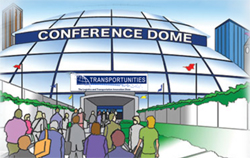 |
August 28, 2014 - Supply Chain Flagship Newsletter |
 |
| SPONSOR: TRANSPORTUNITIES |
||
 |
||
The Logistics and Transportation Insight and Solutions You Need - Without Leaving the Office |
||
October 15, 2014 |
||
 |
|
||||||||||||||||||||||||||||||||||||||||||||||||||||||||||||||||||||||||||||||||||||||||||
The Labor (Day) Supply Chain 2014
|
|||||||||||||||||||||||||||||||||||||||||||||||||||||||||||||||||||||||||||||||||||||||||||
| GILMORE SAYS: |
"There continues to be union action at the Port of LA in an attempt to have independent drayage drivers classified as employees, a huge issue for the Teamsters. " WHAT DO YOU SAY? |
That description of the state of US labor is an interesting one, and largely true based on the data. Yet, as weak as the labor movement has seemingly become in the last few years, there are also some counter trends.
I will also say that the last 12 months have been one of the most meaningful such periods for the labor movement, both positive and negative, in quite some time.
Let's look at some basic data, most from the US Bureau of Labor Statistics.
Though the percent of total US workers that are union members stayed flat in 2013, at 11.3%, for the first time in memory the percent of private sector union members actually ticked up a bit, from 6.6% in 2012 to 6.7% in 2013. But the long-term trend is one of steady decline since the Labor Department started the annual report showing 16.8% union membership in the private sector in 1983.
Again somewhat noteworthy, the percentage of union workers in manufacturing jumped even more, from 9.6% in 2012 to 10.1% in 2013. I simply do not know what is behind that trend - most interesting of course will be to see if it continues, or was a one-time statistical blip.
Unfortunately, despite the clear recovery in US manufacturing - we finally passed the peak 2007 output levels last month, some seven years later - the jobs are not coming back at the same clip.
At the start of the year, there were about 8.4 million non-supervisory manufacturing workers in the US. That's up from the bottom of the recession, when we fell to about 8 million shop floor workers, meaning we've added about 400,000 manufacturing jobs since then.
But in 2004, just a decade ago, there were just over 10 million factory floor workers - we're down 1.6 million positions from that level.
That obviously puts downward pressure on wages, as the demand for workers is simply much lower than the supply, though the lack of wage growth isn't nearly as bad as I would have guessed, based on all the media reports.
According to the BLS, the average hourly wage for shop floor manufacturing workers was about $19.60 per hour at the start of the year. That's up from the $16.00 or so per hour at the start of 2004, or a rise of 22% over 10 years. So wages have risen modestly, but not enough to keep up with inflation, let alone improve a worker's lifestyle.
Meanwhile, there has been steady growth in warehouse jobs, though they represent just a tiny fraction of manufacturing positions. There were about 724,000 warehouse jobs at the start of the years, up from some 542,000 in 2004, a rise of 33% - but even with that growth they only represent about 8.8% of manufacturing floor positions. That surprises me, actually.
In terms of wages, average non-supervisory wages for warehouse workers was $15.34 at the start of the year, about 22% less than average manufacturing pay.
Ok, those are some of the key facts. Now let's look at some of the key events and trends relative to labor over the past year.
The momentum to increase the minimum wage that started early in 2013 gained some traction, with the Federal government mandating a $10+ wage for federal contractors, and a number of cities hiking the minimum in their jurisdictions, led by Seattle, which is phasing in a minimum wage of $15.00, highest in the US.
I think we are far from done with this issue, and Seattle's experiment will be interesting. But to the extent that the minimum wage starts to rise much over ten bucks, it may put some upward pressure of wages for say warehouse workers.
The United Auto Workers rolled out a new strategy late in 2013 to unionize the foreign auto factories, most but not all in the South, and not a one of which is not unionized. Ground zero was a Nissan factory in Canton, MI, targeted by the UAW with an array of unusual tactics. That included focusing more on the external environment than the Nissan workers themselves, from plans to picket Nissan dealers in Brazil during the 2014 World Cup there to recruiting students to distribute union fliers at Nissan dealerships in Mississippi and beyond.
But just when it looked like the Canton factory was going to be the UAW's "last stand," suddenly it moved to Chattanooga, and a newish Volkswagen plant there. That is the only non-union factory among more than 60 VW plants worldwide. Beyond that, VW management in Germany and to a lesser extent in Tennessee seemed to be favoring unionization - definitely a "foreign" concept in the US.
The UAW gathered enough support to force a union vote. Factory management gave the union unprecedented access to workers there. And yet - the union lost. By a vote of 712 against and 626 for, the workers said no to the UAW, in a stinging blow to the union.
There were initially UAW efforts to invalidate the vote, based on comments made from some Tennessee politicians against the union before the election, and with a union-friendly National Labor Relations Board a re-vote seemed a real possibility.
But a short time later, the union pulled the protest, most likely because it figured forcing and losing another vote would be worse than losing this one vote for now. This was one of the biggest supply chain stories of the year, and it will be interesting to see what the UAW's next move will be.
VW was a union setback for sure, but labor is getting some other goodies from the NLRB that will help its cause, perhaps big time. The most notable are proposed rules for so-called "microwave" union elections.
In great summary, these rules would significantly speed up the time from when the union receives enough support to call for an election to when that vote is held - perhaps in as little as just 10 days. Most feel that gives a major advantages to the union, as it can quickly build off its momentum to call for a vote while giving the company little time to conduct a defense.
The NLRB already passed these rules once, but they were invalidated due to procedural reasons. The board has already held hearings. The new rules are going to be adopted, and maybe very soon.
In mid-summer, the NLRB ruled that large fast food restaurant companies were "joint employers" of workers actually employed by local franchise owners. Without going into all the details, the ruling likely would make it easier to organize the entire chain, even though individual outlets are separately owned. McDonald's is appealing.
Amazon survived its first ever union vote earlier this year, with a small group of technicians voting no to organization at a Delaware fulfillment center.
There continues to be union action at the Port of LA in an attempt to have independent drayage drivers classified as employees, a huge issue for the Teamsters. Keep an eye on this one, and the issue of contract drivers everywhere.
Finally and sadly, an innovative labor pact at Spirit Aerosystems appears to be unravelling, after a new CEO took over for former CEO Jeff Turner, who conceived the deal. It involved a long contract, lower guaranteed raises but more profit sharing, and commitments to keep work in Wichita. The new CEO now wants to outsource. The union claims breach of contract, and is suing.
Our story is here: Innovative Labor Pact at Spirit Aerosystems Falling Apart Under Potential Sale of Division, Job Losses. It is a real shame, and a stark reminder of all the contradictions of the labor supply chain.
Any reaction to our summary of the labor supply chain 2014? Let us know your thoughts at the Feedback button (email) or section (web form) below.
![]()
| View Web/Printable Version of this Column |
|
|
|
YOUR FEEDBACK
We received quiote a few emails - mostly from employees - on our On article on the apparent collapse of the innovative labor pack instituted a few years ago at Spriti Aerosystems, after a new CEO took over from Jeff Turner, who drove the new approach. (See Innovative Labor Pact at Spirit Aerosystems Falling Apart Under Potential Sale of Division, Job Losses.)
That includes our feedback of the week on this topic from the company's Gary Crouse, who offers a balanced view of the situation. Other letters say the original deal wasn't at "win-win" as our piece suggested, though on balance it seems most workers liked the pact. Interesting stuff. Some more of these letters next week.
Feedback on the Week on Collapse of Spirit Laor Deal:
It looks like Larry Lawson doesn't give a flip about the workers, and that's the kind of attitude we have always dealt with, mostly with alarming anger and mistrust. The workers here don't trust management any more than they trust politicians, and with good reason. Last year, several managers that I know, hit the door in an alarming rate to us workers, that they knew what was coming down. So now we're back to mistrusting management again, and we're the ones who haven't changed. If you want good productivity, you need the trust of the workers. When I heard that the union had filed suit and what the company is trying to do (which we don't much) I had to make myself get back to work in the same frame of mind that I normally do. I didn't want to do a thing at all. And if you want the workforce's trust, don't keep things from us, let us know the details before the media does. Keeping things hush hush from us doesn't work and it makes us angry. Gary Crouse |
||
| More on Spirit: | ||
Nothing new here. When the big dog wants a change, a change it gets. Here's the thing - All companies like to and must make money (profit). When the amount they make is below what it should be, due to whatever reason, then changes in operations have and will be made. This must happen in every case or the company will fail. Not a really good idea for anyone. When costs to production increases to point that minor adjustments cannot solve the problem then large adjustments will be made. When the reason is that work performed by their employees falls below that scale which bas been developed and proven to be a valid measuring stick, and the cost to produce an item exceeds that item's value, then changes must be made. When workers production is so low per units manufactured that costs exceed value, changes have to be made. The fix hurts some far more than some others, however that is not a valid reason for the company to shirk it's responsibility to make a profit. The most appropriate fix to the problem and that effects far fewer employees is to accurately identify those whose production falls short of required levels. Those employees need to be terminated and their jobs filled by personnel who will produce to the established standard thusly bringing production costs in balance and allowing a profit to the company. And best of all, for the majority of the employees continued employment. Think about it, would you want to pay someone to do a job for you that should take three hours and takes that employee five hours and costs you almost twice as much as it should. I wouldn't and I don't think you would either. Do it now and do it correctly and lets all get with the program and save our jobs and the company.
R.W. MASTERS
|
||
As much as we distrusted Turner, he pretty much kept his word and worked with the Union, and as an ex Union Shop Steward I know this to be true. However since "Lawless Lawson" took the reins, its been a different story. Management talks the talk of needing worker input, worker ideas, worker spotting problems and advice on a solution since we are the "Process Experts" and have the most knowledge. When it comes to implementing his talk, its all talk, we are told there is no money for small changes, to fix equipment, tools, etc.... Yet we have millions of $'s on hand, thus the high stock prices, but things continue to fall apart and be done the same old ways, costing us money that L.L. says we need to be saving. His solution is the "Old fashioned way", sell off, lay off, look for excuses to fire, etc..... Then wonder why moral is in the dumps.... Get rid of L.L., bring in someone like, but not exactly like, Turner, finish turning this place the rest of the way towards a new future of doing things, cut the BIG Boys salaries they don't earn and limit bonuses to only when the do earn them.
John De Armond
|
||
This company used to be family-owned. Now it's only about the rich getting richer. The hell with the middle class people that keep the jerks pockets filled! The Union will win and the company will end up failing and taking a huge loss like usual. People need to realize that the whole town of Wichita will take a huge hit if they continue to contract jobs for cheap unqualified workers. Spirit is falling apart and that won't change until someone stops the Lawsons and Turkles of the company! They receive the 1 million dollars or more in bonuses while the real people suffer. The people will get even, it's just a matter of time!
Bill Smith
|
SUPPLY CHAIN TRIVIA ANSWER
Q: North Carolina has the lowest rate of total unionization (public and private sectors). What is it?
A: Just 3%, versus the overall US average of 11.3%.
| © SupplyChainDigest™ 2003-2014. All Rights Reserved. SupplyChainDigest PO Box 714 Springboro, Ohio 45066 |
POWERED BY: XDIMENSION
|










